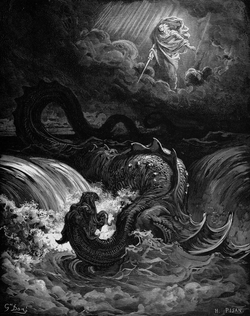 |
| From wikipedia - "Destruction of Leviathan". 1865 engraving by Gustave Doré |
Dragons - a large subject to be sure. Firstly, I'd encourage everyone to go and visit the Wikipedia "Dragons" page because its a great article with lots of information and we don't want to simply re write it here. That will give you lots of insight into the subject. But don't go there just yet because this is a research community and there are a number of points of discussion first...........
We'll start with the word Chaos. It's a word we are probably more used to being associated with household disorder, the series 'Get Smart' or a comedy club chain. In ancient Greek it refers to a state lacking order or predictability. In Cosmogony (see expansion of term below) it refers to the ancient abyss or chasm, the primeval world.
But in the world of mythology - chaos - the state of the earth and the universe prior to creation, is also the place where we find the dragon. The oceans were a fearful place as the world was created. Leviathan, the primordial sea-monster lived there. Most ancient near and middle eastern people could not swim, and saw the ocean as a fearful and foreboding place. What was on the periphery of the ocean? What existed at it's edge? What monstrous beasts from out of the primeval chaos would we encounter - that's the view of the ancient world.
In the Chaoskampf, the ancient battle or struggle in the creation myths or the formless and void state of the earth often involve gods and Dragons or the "Mighty Men of Old, the Men of Renown" the Nephilim or similar heroes of mythology from Genesis vs dragon type figures. We see this ancient struggle also used in stories and devices such as Michael the Archangel vs the Dragon in the book of Revelation and in more recent stories such as St George and the Dragon and the Lambton worm story (which we will look at in greater detail in weeks to come).
The dragon represented the powers behind evil and chaos in the ancient world. The Caananite myths also reflect this dragon-behind-the-chaos mythology and I would encourage you to read the Catholic Version of the Bible to see the stories in the book of Daniel and Bel and the Dragon to see an expansion on this topic straight from an ancient source (I recommend that we don't do big quotes from literature because you should do your own research, that's why we tend to ask more questions than we answer - the community does the research together). Read Job 7:12; 41:1-11 and Psalm 74:13-14. What insights does this give us on the ancient view of dragons and serpent type creatures? What does it tell us about God? Does it literally refer to dragons or is God meeting culture where they are at in their own mythology? Is the inspired author using this as a device to show people how God ultimately intervenes and deals with fear and chaos by bringing victory and hope? It's really, really important to do your own research on ancient near eastern cosmology (The science of the origin and development of the universe) and cosmogony (The evolution of the universe) to understand the literary devices used in relation to this subject. When you realise how ancient people viewed the universe, you will understand the stories in a way much more richly and more importantly......accurately.
The dragon is also used later on to derscribe Egypt and Babylon as corruptand idolatrous powers opposing God - and much further on in the bible in the book of Revelation we see that the dragon is the evil spiritual and political power behind the beast (Who is in Rome - whether practically or metaphorically).
So in part 1, we establish the middle/near eastern motiffs, symbols and stories from the ancient world of the dragon representing the dark powers lurking behind the shadows of creation, doing battle against God or the other near eastern deities and representing the adversarial power that opposes the good works of God and men.
But what of the reality of dragons as a real physical being. Are there any truths to the stories of St George and the Lambton Worm. Next week Bryony will take a look at Dragons in the medieval world and how they became so prevalent in story and heraldry - which are still part of our mythology in movies and books today.
God bless you - Pastor Baz.

No comments:
Post a Comment